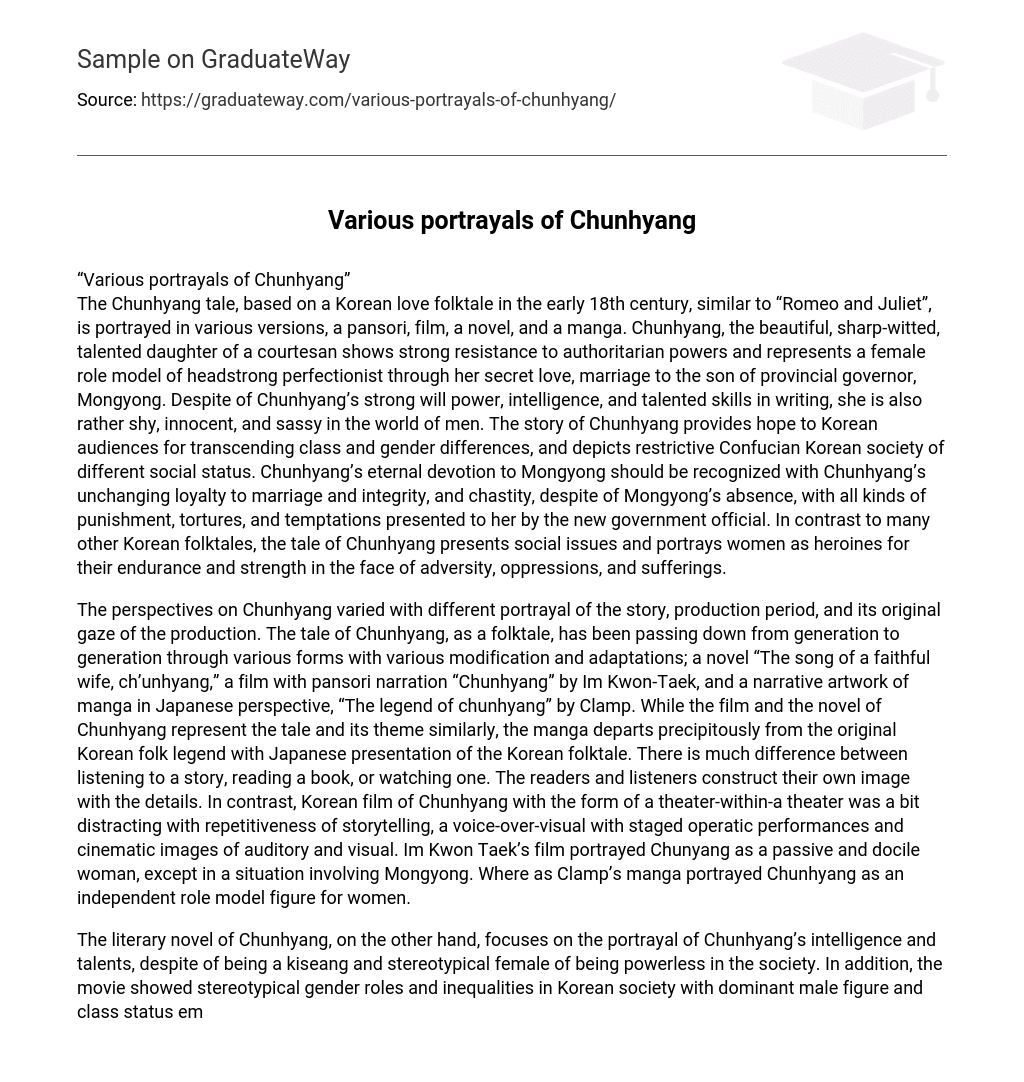The Chunhyang tale, based on a Korean love folktale in the early 18th century, similar to “Romeo and Juliet”, is portrayed in various versions, a pansori, a film, a novel, and a manga. Chunhyang, the beautiful, sharp-witted, talented daughter of a courtesan shows strong resistance to authoritarian powers and represents a female role model of headstrong perfectionist through her secret love, marriage to the son of a provincial governor, Mongyong. Despite of Chunhyang’s strong will power, intelligence, and talented skills in writing, she is also rather shy, innocent, and sassy in the world of men. The story of Chunhyang provides hope to Korean audiences for transcending class and gender differences, and depicts a restrictive Confucian Korean society of different social status. Chunhyang’s eternal devotion to Mongyong should be recognized with Chunhyang’s unchanging loyalty in marriage and integrity, and chastity, despite of Mongyong’s absence, with all kinds of punishment, tortures, and temptations presented to her by the new government official.
In contrast to many other Korean folktales, the tale of Chunhyang presents social issues and portrays women as heroines for their endurance and strength in the face of adversity, oppressions, and sufferings.
The perspectives on Chunhyang varied with different portrayal of the story, production period, and its original gaze of the production. The tale of Chunhyang, as a folktale, has been passing down from generation to generation through various forms with various modifications and adaptations; a novel “The song of a faithful wife, ch’unhyang,” a film with pansori narration “Chunhyang” by Im Kwon-Taek, and a narrative artwork of manga in Japanese perspective, “The legend of chunhyang” by Clamp. While the film and the novel of Chunhyang represent the tale and its theme similarly, the manga departs precipitously from the original Korean folk legend with Japanese presentation of the Korean folktale.
There is much difference between listening to a story, reading a book, or watching one. The readers and listeners construct their own image with the details. In contrast, Korean film of Chunhyang with the form of a theater-within-a theater was a bit distracting with the repetitiveness of storytelling, a voice-over-visual with staged operatic performances and cinematic images of auditory and visual. Im Kwon Taek’s film portrayed Chunyang as a passive and docile woman, except in a situation involving Mongyong. Where as Clamp’s manga portrayed Chunhyang as an independent role model figure for women.
The literary novel of Chunhyang, on the other hand, focuses on the portrayal of Chunhyang’s intelligence and talents, despite of being a chosen and stereotypical female being powerless in the society. In addition, the movie showed stereotypical gender roles and inequalities in Korean society with dominant male figure and class status, emphasizing heartfelt flashes of Chunhyang’s character, whereas in the manga, the more pro – feminist, heroic, righteous, fierce, and talented fighter characteristics of defying authorities were depicted, with comical drawings of martial and supernatural abilities, to portray perfect role model of a physically and emotionally independent women for particularly the female gaze.
For example, Clamp depicts Chunhyang with Monryung’s saying of “I keep asking you, if you’re going to use violence, you really have to warn me,” as if Chunhyang is violent, in addition to frequent scenes where Chunhyang rescues of the villagers from the tyrannical rulers, “yangban.” In contrast, the film staying true to the folktale of Chunhyang, Im Kwon-Taek staged the tale within the 18th century and portrayed Chunhyang with a stereotypical female characteristic of women being very subservient to men under Confucianism. Furthermore, Im Kwon Taek’s film, in addition to emphasis on women’s role, also focused on the loyalty and staying true to one’s values more than it is about sex, whereas Japanese version of Chunhyang is considered more about Chasity and women is more sexualized, with presentation of younger age or more of naive and innocent but strong and heroic figure, striving for justice and self-righteousness.
Interestingly, the film that displays gender conflict within Korean society stays within the male privileges of voice by the male voicing of pansori over female, Chunhyang, speaking voice. Overall, the rise of various versions of Chunhyangjon, its popularity, occurred during the colonial period. With translational discourses and limitation, and colonial discrimination during the colonial period, Japanese version of Korean literature lost its traditional values of virtuosity and loyalty. Korean culture, with its ancient history and indigenous traditions, includes inheritance from China and passing legacies on to Japan during the colonial period. Thus, the differences of the same folktale may be the result of a different production period and its original gaze of the production.
During the Japanese colonial period, with Japanese ruling over Korea, colonial domination, with Japanese Governor and General in Korea enforces military rules, assimilation policies, and restrictions in various aspects, Korea’s independence, spirit, self-reliance, and expression were dramatically decreased. Thus, the difference in the Japanese version of Chunhyang tale by Clamp is probably due to misrepresentation of Korean culture and customs to the colonizers, Japanese perspectives, and losts of original Korean culture and literature through translation. The difference in the medium of expression made translation, secondary and inferior to the original.





